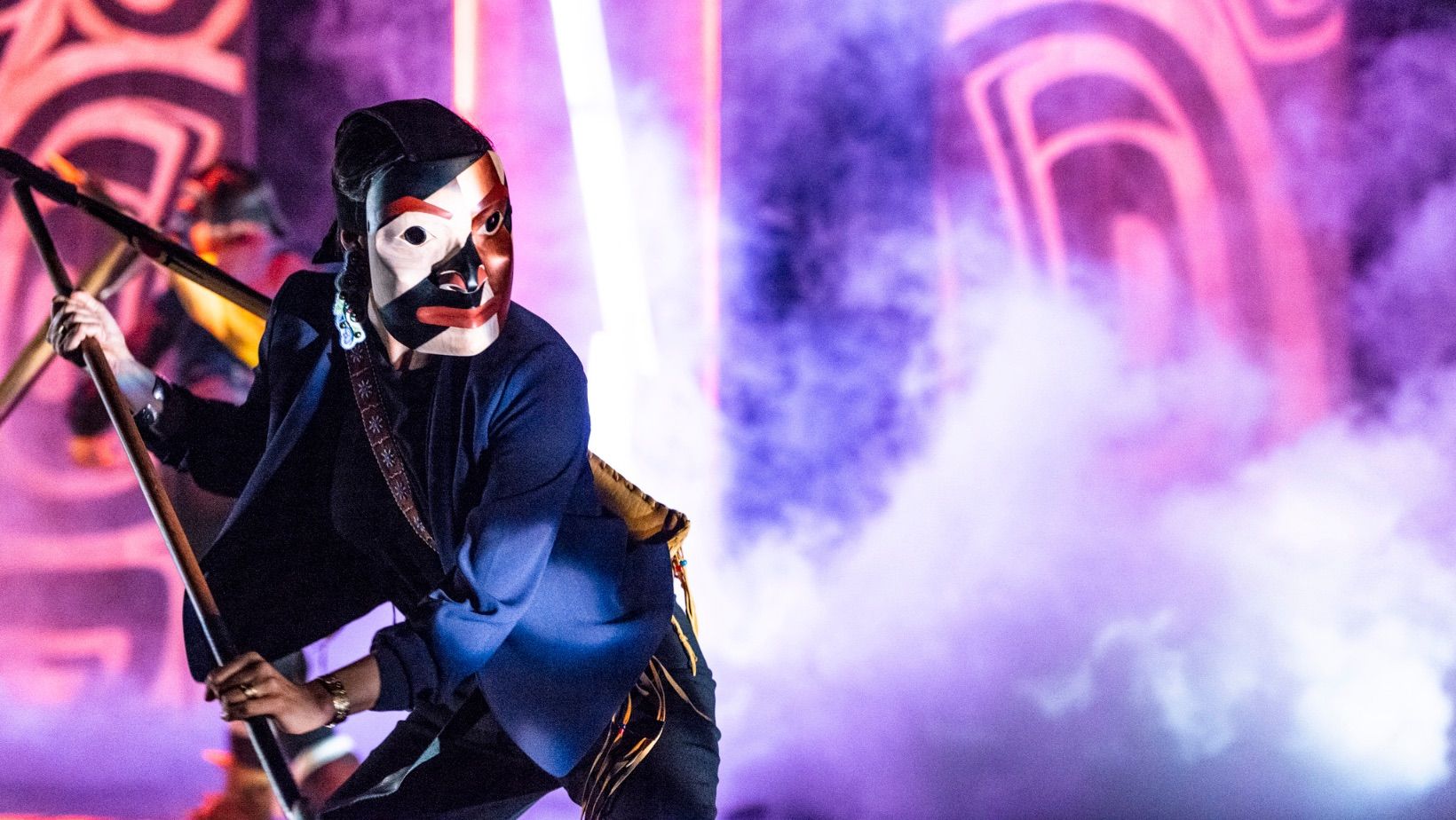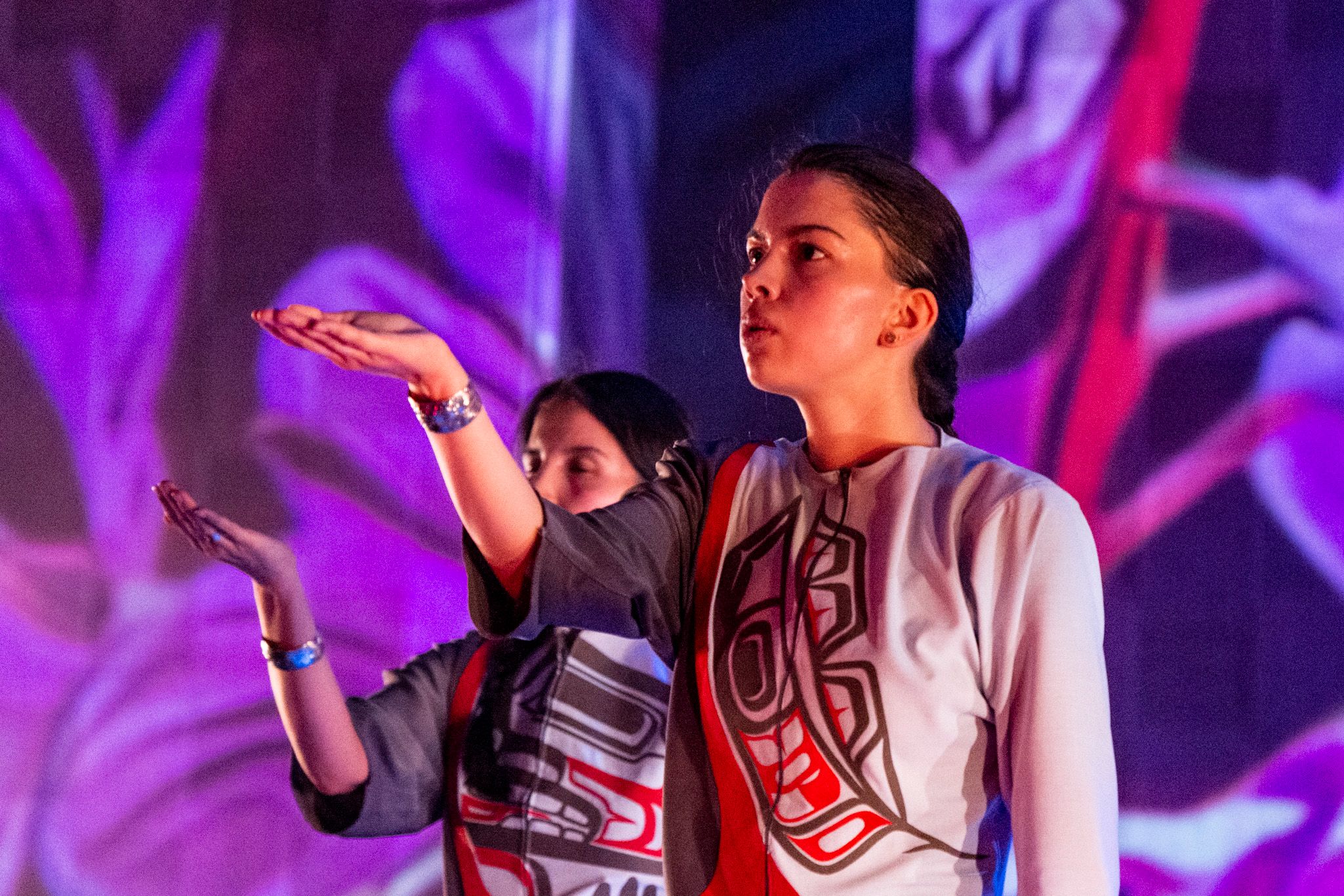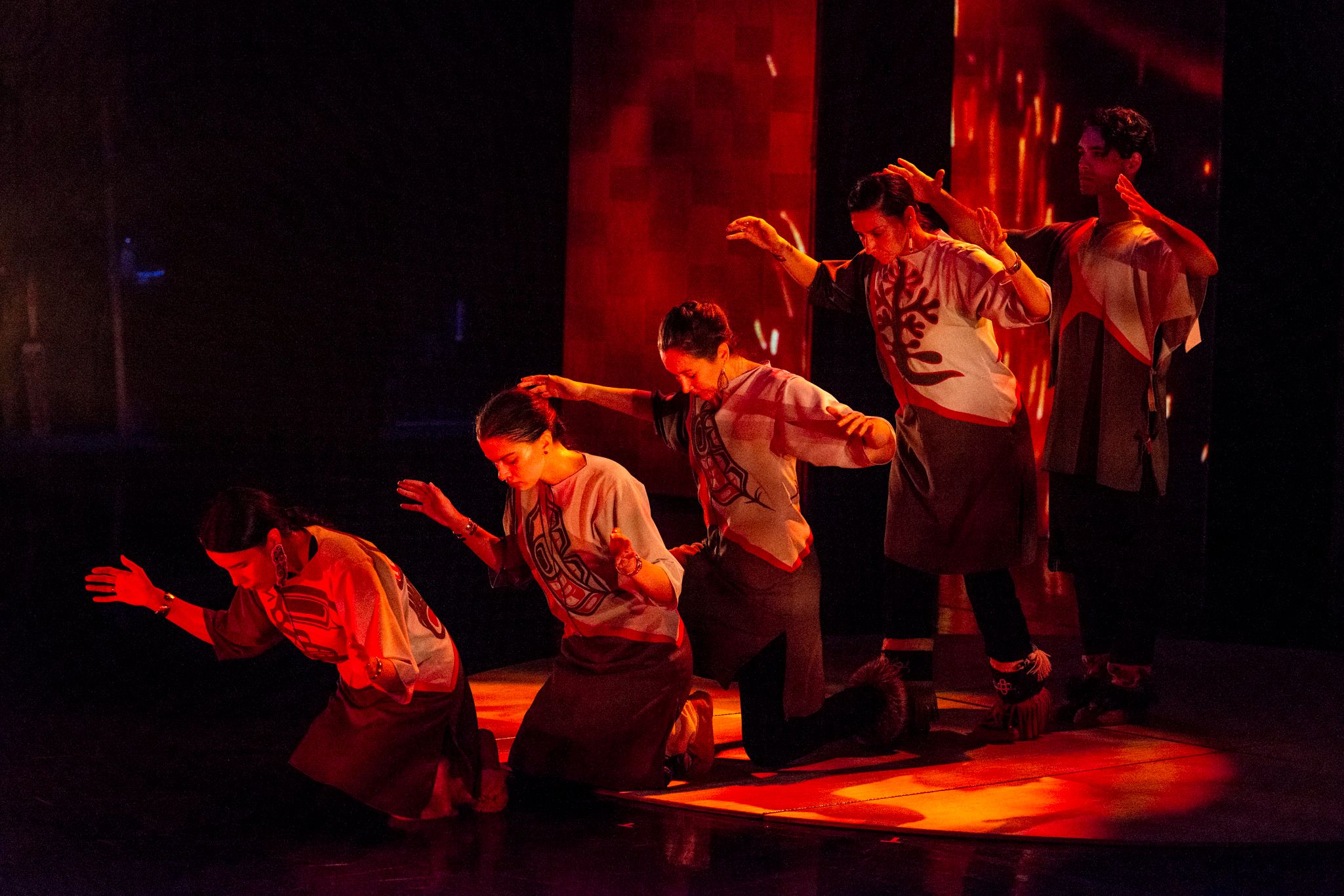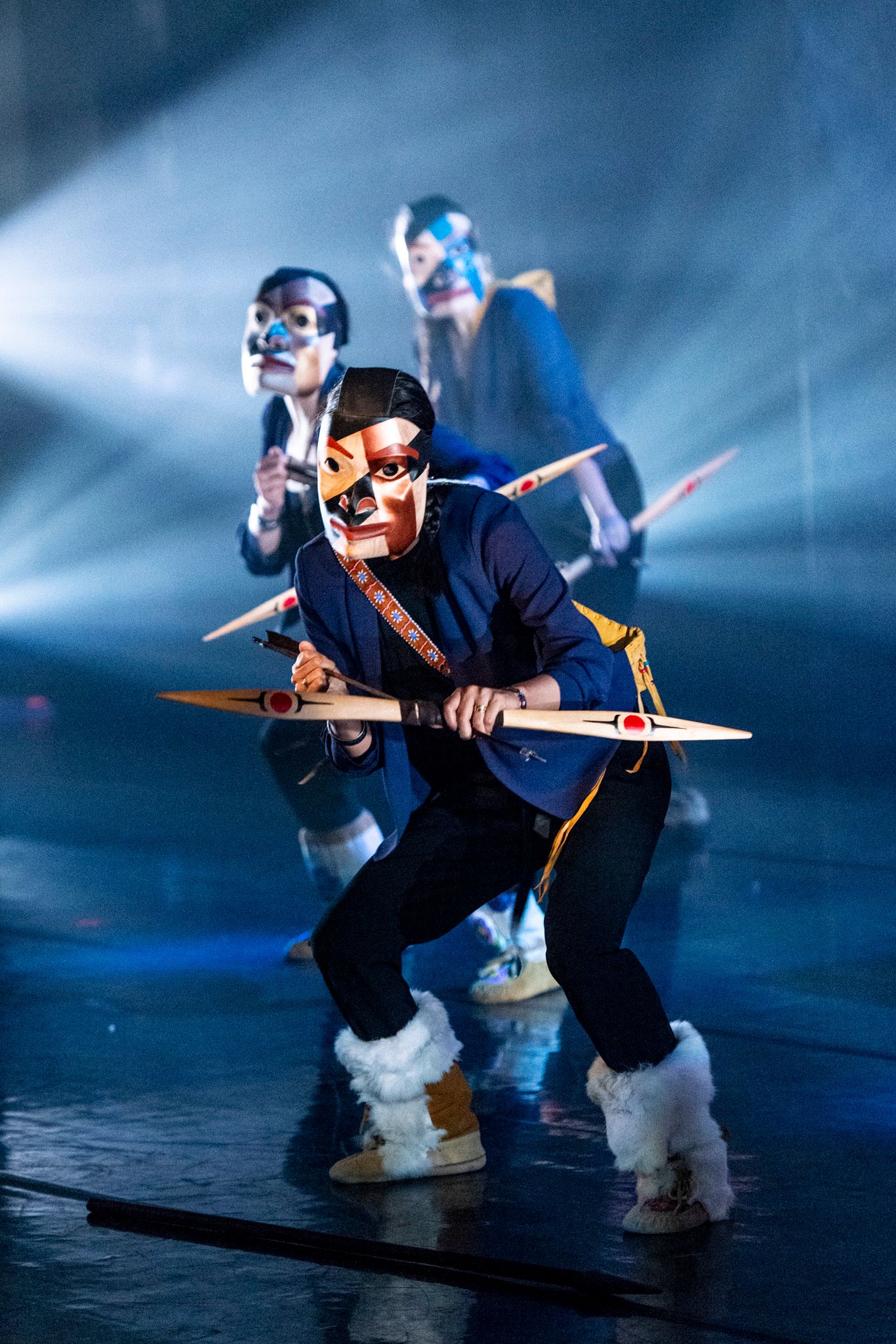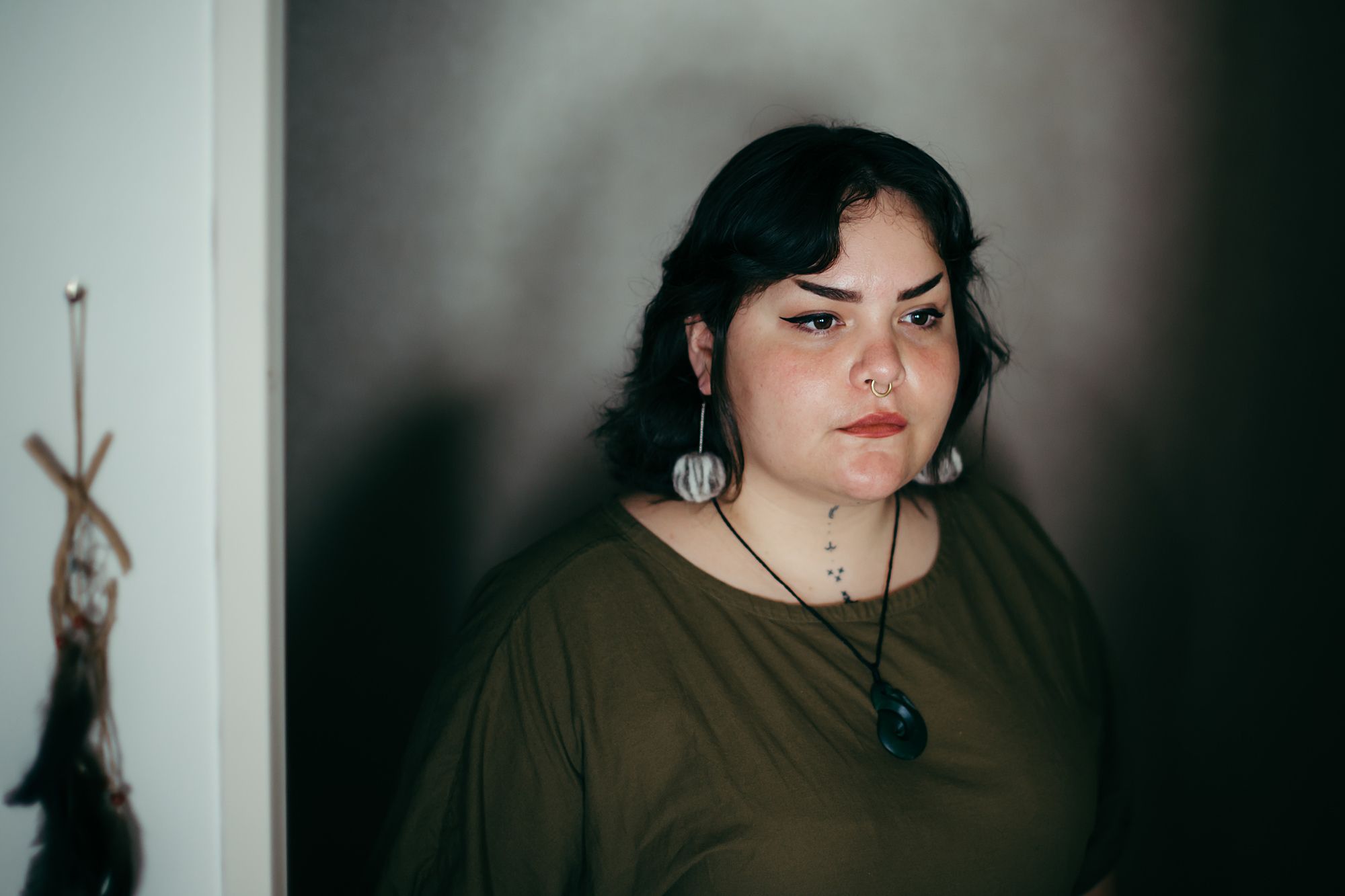The Transformation of Fear: A Review of Mînowin
The Dancers of Damelahamid transport audiences at Kia Mau Festival over 14,000 km away, to the West Coast of Turtle Island. Kōtuku Titihuia Nuttall reflects on the timeless narratives and Indigenous connections offered through traditional songs and dance.
Even though there are over 14,000 kilometres between the Skeena River and Te Whanganui-a-Tara, this year the Kia Mau Festival played host to the Dancers of Damelahamid, a group of performers from the Northwest Coast of British Columbia who revitalise traditional songs and dance. With multimedia production and timeless narratives, the Dancers of Damelahamid share the legacy of their people on stage. Aotearoa and Turtle Island have strong ties between their Indigenous peoples, despite the distance, which are often maintained and strengthened through cultural exchange in areas like language revitalisation, performance arts, canoe and waka journeys, and visual arts. Mînowin was immediately at the top of my list to see at this year’s Kia Mau Festival, in the spirit of such exchange. It is a total privilege to be able to experience a performance from so far across the ocean, especially in these uncertain times.
Hone Kouka, Artistic Director of Kia Mau, introduces the show with a quick mihi. The performances are taking place at Te Whaea, which has a small, dark stage and a set of modest bleachers for the audience. Kouka explains that, in 2019, Margaret and Andrew Grenier, who head the Dancers of Damelahamid, visited Aotearoa and expressed interest in bringing one of their works to the next festival. Kouka responded enthusiastically and was able to show the pair several venues in Te Whanganui-a-Tara, but it was Te Whaea that caught their eye. Even in the near darkness, I can see why. The theatre is intimate, the stage close enough to afford a kind of closeness with the performers.
Mînowin starts slowly, figures slipping out of the darkness, to the sound of a wooden whistle being blown by the main narrative figure. Unmasked, this dancer guides out other performers in button blankets and cedar masks. This regalia is particular to the Northwest Coast—button blankets drape around the shoulders, made of black or blue fabric, with red appliqué designs. White mother-of-pearl buttons highlight the designs. The masks are some of the most important figures in storytelling: Raven, Eagle, Orca and Wolf. Most of the stage remains in darkness, but projected onto the floor in turn, across a flat circle of wood, are the cosmoses. The performers dance around them one by one, inhabiting the creatures they are dressed as, transforming themselves in front of us, telling a story of creation.
The performers dance around them one by one, inhabiting the creatures they are dressed as, transforming themselves in front of us, telling a story of creation.
Each dance peels away from the next. There are layers of set design, regalia and narratives, which weave together different forms and media to create the show. One number throws the stage into darkness again, dayglo orca puppets dancing across the stage between the performers. The projections on the back screens are like water, the sounds overlaid like the amniotic rush of the ocean. For each dance, the performers emerge in new clothing; each outfit carefully put together to connect to the stories being told. Some are simple smocks with large prints, others are exceedingly complex – full sets of fancy dancing regalia, or glittering white shawls. The regalia is mostly coastal, but I notice some designs and beadwork that harken to a Métis style. Métis are sometimes known as the ‘Flower Beadwork People’ for their intricate and recognisable designs.
While researching this piece I learned that the Dancers of Damelahamid are a family group. The Greniers, along with some of their children and other relations, have carried on the group founded by their parents, Chief Kenneth Harris (Gitxsan) and Elder Margaret Harris (Métis), both of whom were instrumental in the revitalisation of performance traditions in their own communities and beyond. This thread of intergenerational connection is very clear throughout. Although most of the show is unnarrated, there are small sections of overlaid speaking, in English and, I imagine, Gitxsan. Some of the voices are older, passing on their stories directly to the audience.
This thread of intergenerational connection is very clear throughout.
I am very grateful to have received the experience of these stories, some from the very beginning of time – the first mud dragged up to the surface of Earth’s waters by Muskrat, which created Turtle Island; the long journeys of Wolf to make sure the new land was wide enough for all the people to live on. One dance about fire sets the stage alight with projections of flames across the back panels. A voice tells the story of fireweed (a plant with multiple uses as an edible, or as a weaving fibre) and the designs on the front of the dancers’ outfits become clear; soft pink branches reaching up and out over magenta smocks. Where I am from, in Coast Salish territory, we have very beautiful and sacred meadows that grow between oak trees. Before colonisation we grew our food in these meadows and used controlled burns to care for the land. Fireweed is instantly recognisable – the bright blooms are the first to appear after a fire, turning whole fields and meadows pink.
Some highlights of the show include a few live songs: the performers are all very focused and intent on their routines for most of the show, so it is amazing to hear their voices suddenly break through. Decorated drums accompany some of these songs, with their asymmetrical heartbeat rhythms. Another number sees performers sweeping the centre circle of the stage with boughs of cedar, a renowned rongoā from Turtle Island, often used for its cleansing properties. As the masked figures sweep the floor in swinging rhythms, projections are cast onto the centre circle – swatches of light and colour, as if painted by the cedar.
As the show spirals towards the end, more and more human figures appear, as well as more modern clothes. Interpersonal events take place, weapons are drawn. Someone is picked to embark on a quest. This lone figure dons a cedar hat and accepts a staff with a bird carved on top – Eagle or Raven – the length of the staff all red cedar wood. In the show’s crescendo, the staff strikes the floor, and the central panel onstage lights up – with a crack – jagged and bright orange.
Transformation will be necessary, the transformation of fear. I take this to mean we will need to move beyond the fear that holds us back from engaging with the world around us
The performer then addresses the audience, first in her language, then in English. She tells the story of Mînowin – how the show is made of the stories and teachings of their people, their elders, and knowledge that was once suppressed by colonisation and potlatch bans. She says the time is coming when this knowledge will be necessary again, that the staff will split the earth, and we will need to remember the lessons from these stories. Transformation will be necessary, the transformation of fear. I take this to mean we will need to move beyond the fear that holds us back from engaging with the world around us (beyond fear of not being the correct kind of Indigenous, perhaps, or whatever keeps us away from our Indigeneity) and to return to our whakapapa and tikanga in order to weather future difficulties. We should not be focusing on the fear – of colonialism, of language loss, of judgement – but instead we should transform this energy and emotion into actions that connect us to our pasts and to one another.
If the Dancers of Damelahamid return to Aotearoa, with Mînowin or another show, I implore you to attend. The multimedia experience they have created transports the viewers through time, with stories that have eternal importance. Even though the sets are simple, they draw the audience through coastal forests far away. I feel so lucky to have caught this performance, to learn the importance of the teachings that came before. As the show closes and the dancers take their bows, they raise their hands in a gesture common across the West Coast of Turtle Island. Palms raised to eye level, facing inward, softly swaying. This ‘raising hands’ is a gesture and phrase of thanks, of acknowledgement, as ancient as the stories told in Mînowin.
Mînowin by Dancers of Damelahamid
14–17 June 2023
Kia Mau Festival
